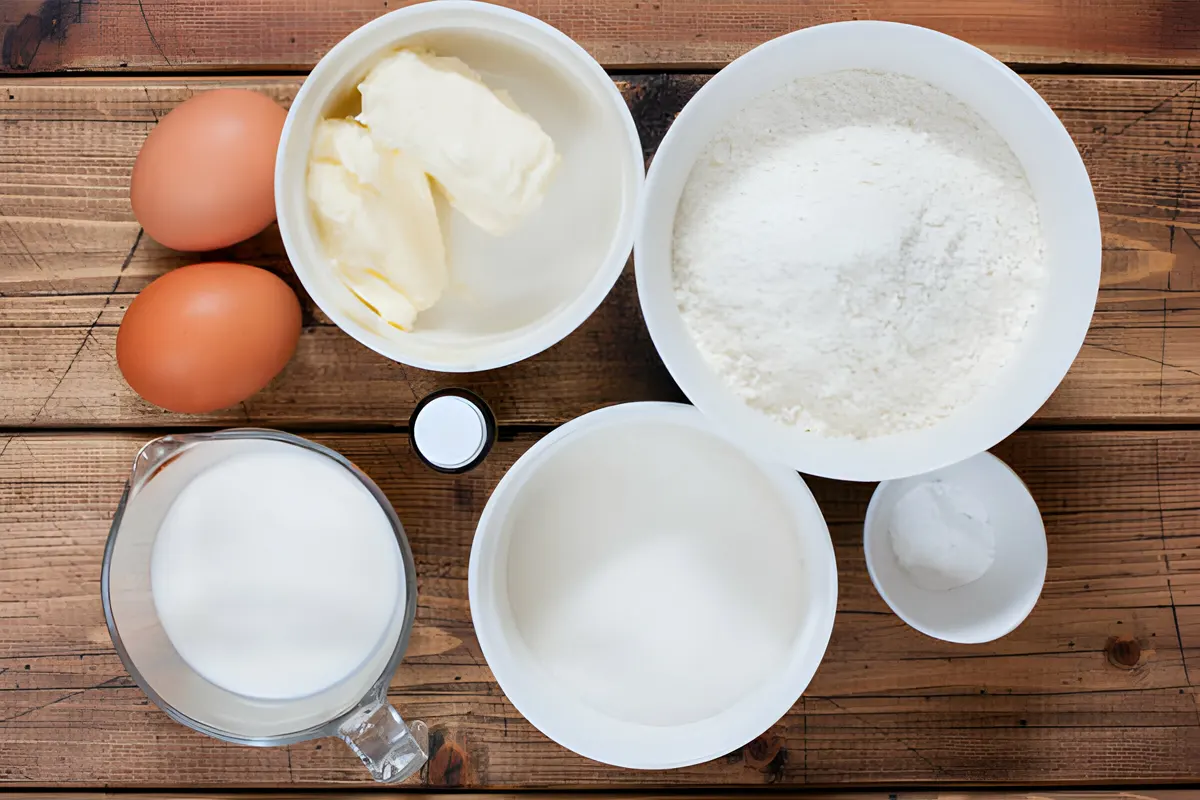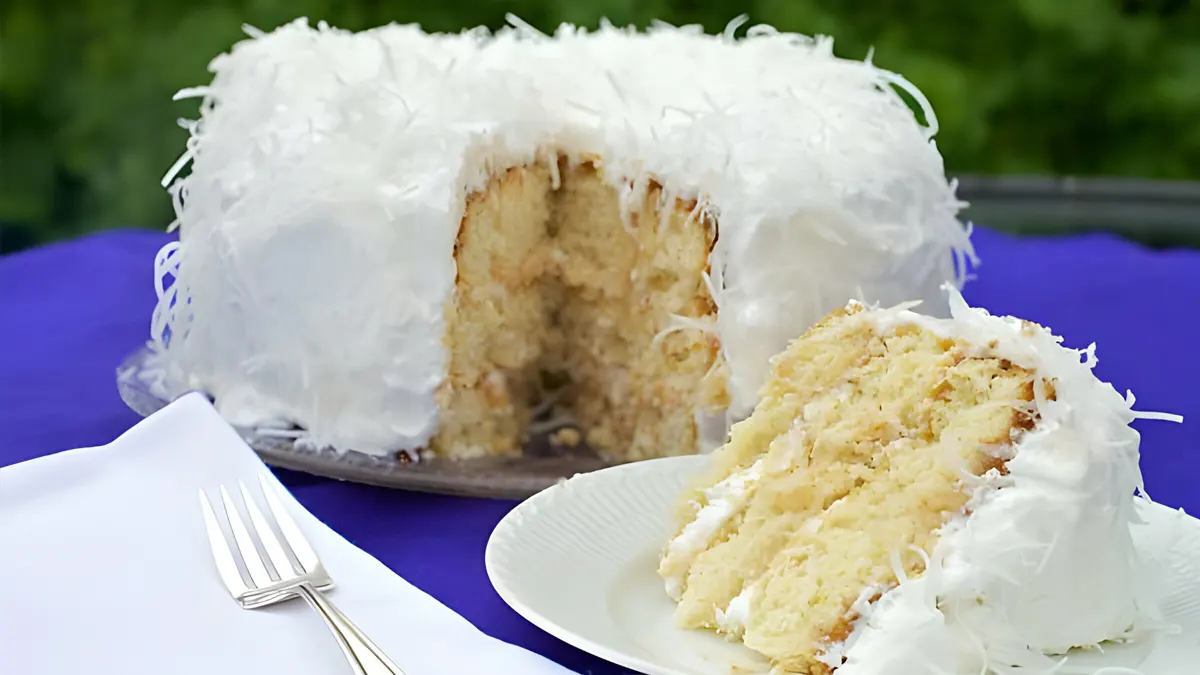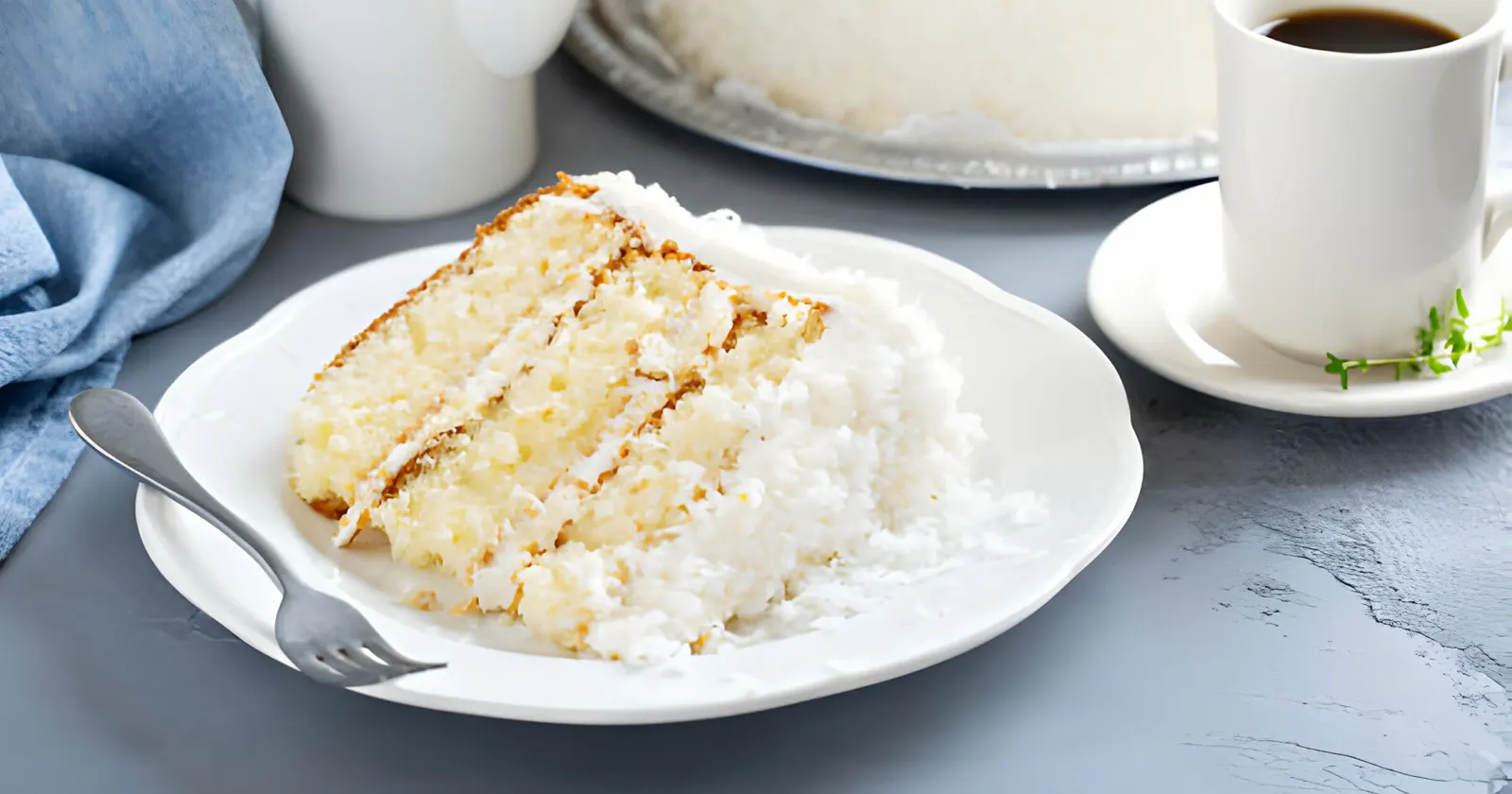Introduction
Coconut cake, with its tropical allure and delightful flavor, stands as a beacon of indulgence in the realm of desserts. This timeless confection has captured the hearts and palates of food enthusiasts across the globe, offering a symphony of coconut-infused goodness in every bite. In this comprehensive guide, we embark on a journey to unravel the essence of coconut cake—from its rich history to its varied incarnations, culminating in a detailed exploration of its tantalizing preparation. Join us as we delve into the tantalizing world of coconut cake, where every slice promises a taste of paradise.
History and Origins of Coconut Cake
The roots of coconut cake trace back to tropical regions where coconut palms sway in the warm breeze, such as Southeast Asia, the Caribbean, and the Pacific Islands. Coconuts, with their versatile meat and refreshing water, have long been a staple in the culinary traditions of these regions.
The evolution of coconut cake as a distinct dessert can be attributed to the intersection of cultures and cuisines. Historical records suggest that coconut-based sweets were enjoyed in ancient times, with evidence of coconut desserts dating back thousands of years.
As trade routes expanded and global exploration flourished, coconuts found their way into the kitchens of Europe, where they became prized ingredients in desserts. Colonial powers introduced coconut cakes to new territories, where they merged with local culinary traditions to create unique variations of the dessert.
Over time, coconut cake recipes evolved to suit different tastes and preferences. From simple coconut-flavored cakes to elaborate layer cakes adorned with frosting and coconut shavings, coconut cake has become a beloved dessert enjoyed by people of all ages and backgrounds.
Essential Ingredients for Coconut Cake

Creating a heavenly coconut cake requires a careful selection of ingredients that harmonize to deliver a symphony of flavors and textures. Let’s delve into the essential components that bring this delectable dessert to life:
Dry Ingredients
- Flour: All-purpose flour serves as the foundation of the cake, providing structure and texture. For a gluten-free option, consider using almond flour or a gluten-free flour blend.
- Baking Powder: A leavening agent that helps the cake rise and achieve a light, airy crumb. Be sure to use fresh baking powder for optimal results.
- Salt: A pinch of salt enhances the flavor of the cake and balances the sweetness of the other ingredients. Himalayan pink salt or sea salt can add depth to the flavor profile.
Wet Ingredients
- Butter or Oil: Butter adds richness and moisture to the cake, while oil can yield a slightly more tender crumb. Consider using coconut oil for an extra hint of coconut flavor.
- Sugar: Granulated sugar sweetens the cake and contributes to its structure and moisture content. For a healthier alternative, you can use coconut sugar or a sugar substitute like erythritol.
- Eggs: Eggs provide structure and stability to the cake, helping it rise and hold its shape. If you’re vegan or allergic to eggs, you can use flax eggs or aquafaba as substitutes.
- Coconut Milk: The star ingredient that infuses the cake with coconut flavor and richness. Opt for full-fat coconut milk for the best results, and don’t forget to shake the can well before using.
- Vanilla Extract: Adds depth and warmth to the cake’s flavor profile. You can use pure vanilla extract or vanilla bean paste for a more intense vanilla flavor.
These carefully selected ingredients lay the groundwork for a sumptuous coconut cake that’s sure to delight your taste buds.
Variations of Coconut Cake Recipes
Coconut cake recipes offer a spectrum of delightful variations, each adding its own unique twist to this beloved dessert. Whether you prefer a classic rendition or are eager to explore innovative adaptations, there’s a coconut cake recipe to suit every palate. Let’s explore some popular variations:
Traditional Coconut Cake: A timeless favorite, the traditional coconut cake embodies simplicity and elegance. Moist coconut-flavored layers are sandwiched together with creamy frosting and adorned with shredded coconut for a classic finish.
Coconut Layer Cake: For those who crave decadence, the coconut layer cake delivers indulgence in every bite. Multiple layers of tender cake are generously slathered with coconut frosting, creating a towering masterpiece that’s as stunning as it is delicious.
Coconut Cream Cake: Indulge in the ultimate coconut experience with a luscious coconut cream cake. Rich pastry cream or custard is nestled between layers of moist cake, infusing each slice with creamy coconut goodness.
Vegan Coconut Cake: Plant-based enthusiasts rejoice! Vegan coconut cake offers all the flavor and texture of the traditional version, minus the animal products. Coconut oil, non-dairy milk, and flax eggs come together to create a compassionate dessert that’s sure to satisfy.
Gluten-Free Coconut Cake: Embrace inclusivity with a gluten-free coconut cake that’s suitable for all dietary preferences. Almond flour, coconut flour, or a gluten-free flour blend replace traditional wheat flour, resulting in a tender, gluten-free treat that’s perfect for sharing.
Whether you’re a purist or an adventurous baker, these variations of coconut cake promise to delight your senses and transport you to a tropical paradise with every mouthful.
Expand your culinary horizons with our other tantalizing recipes:
- Dive into the addictive flavors of our Captain Rodney’s Dip, a crowd-pleasing appetizer that’s perfect for parties and gatherings.
- Cure your sweet tooth cravings with our Italian Hangover Cake, a decadent dessert that’s guaranteed to lift your spirits.
- Add a burst of flavor to your meals with our irresistible Chicken Crack Seasoning, a versatile seasoning blend that’s sure to become a pantry staple.
Stay tuned for more culinary adventures as we continue to explore the world of delicious flavors and recipes!
Step-by-Step Preparation Guide
Creating a heavenly coconut cake is a delightful journey that involves precision, patience, and a touch of culinary magic. Follow this step-by-step guide to bring this tropical delight to life in your own kitchen:
1. Preparing the Cake Batter
a. Mixing Dry Ingredients: In a large mixing bowl, sift together the flour, baking powder, and salt. Whisk until well combined, ensuring there are no lumps.
b. Creaming Butter and Sugar: In another bowl, cream together the butter and sugar until light and fluffy. This step aerates the mixture and helps create a tender crumb.
c. Adding Eggs and Vanilla: Beat in the eggs, one at a time, followed by the vanilla extract. Mix until smooth and well incorporated.
d. Alternating Flour and Coconut Milk: Gradually add the dry ingredients to the wet ingredients, alternating with coconut milk. Mix until just combined, being careful not to overmix.
2. Baking the Cake Layers
a. Preparing Cake Pans: Grease and flour your cake pans to prevent sticking. You can also line the bottoms with parchment paper for easier removal.
b. Pouring Batter into Pans: Divide the batter evenly between the prepared cake pans, smoothing the tops with a spatula for even baking.
c. Baking at the Right Temperature: Preheat your oven to the recommended temperature and bake the cake layers until golden brown and a toothpick inserted into the center comes out clean.
3. Making Coconut Frosting
a. Creaming Butter and Cream Cheese: In a mixing bowl, beat together softened butter and cream cheese until smooth and creamy.
b. Incorporating Powdered Sugar and Coconut Milk: Gradually add powdered sugar to the mixture, beating until smooth and fluffy. Add coconut milk as needed to achieve the desired consistency.
c. Adding Shredded Coconut: Fold in shredded coconut to the frosting for added texture and flavor.
4. Assembling and Decorating the Cake

a. Cooling Cake Layers: Allow the cake layers to cool completely on wire racks before assembling.
b. Frosting Between Layers: Place one cake layer on a serving plate and spread a layer of coconut frosting on top. Repeat with the remaining layers.
c. Frosting the Entire Cake: Use the remaining frosting to cover the entire cake, smoothing it out with an offset spatula for a polished finish.
d. Decorating with Coconut Flakes or Shavings: Garnish the top of the cake with additional shredded coconut for an extra touch of tropical flair.
With these simple steps, you’ll be on your way to creating a masterpiece of coconut cake that’s sure to impress!
Serving Suggestions and Pairings
Once your coconut cake masterpiece is complete, it’s time to savor and enjoy every delectable bite. Here are some serving suggestions and pairings to elevate your coconut cake experience:
1. Serving Suggestions:
a. Room Temperature: Allow the cake to come to room temperature before serving. This allows the flavors to fully develop and the frosting to soften for a more enjoyable texture.
b. Garnishes: Enhance the presentation of your coconut cake by garnishing with fresh coconut shavings, toasted coconut flakes, or edible flowers. These decorative touches add visual appeal and complement the tropical flavors of the cake.
c. Accompaniments: Serve slices of coconut cake alongside a dollop of whipped cream or a scoop of coconut ice cream for an extra indulgent treat. Fresh berries or tropical fruits like mango or pineapple also make delightful accompaniments.
2. Pairings:
a. Coffee: The rich, bold flavors of coffee pair beautifully with the sweet and coconutty notes of the cake. Serve your coconut cake with a freshly brewed cup of coffee for a delightful morning or afternoon treat.
b. Tea: For a more delicate pairing, opt for a fragrant cup of tea such as jasmine or green tea. The subtle flavors of tea complement the sweetness of the cake without overpowering it.
c. Coconut-Flavored Drinks: Double down on the coconut goodness by pairing your coconut cake with a refreshing coconut-flavored beverage such as coconut water, coconut milk latte, or coconut rum cocktail.
By paying attention to serving suggestions and pairings, you can elevate your coconut cake experience and create memorable moments with friends and family.
Tips and Tricks for Baking the Perfect Coconut Cake
While baking a coconut cake is a delightful endeavor, a few tips and tricks can ensure that your creation turns out perfect every time. Here are some expert recommendations to help you achieve coconut cake perfection:
1. Selecting Quality Ingredients:
- Choose high-quality ingredients for the best results. Opt for fresh coconut milk, organic eggs, and pure vanilla extract to enhance the flavor of your cake.
2. Proper Mixing Techniques:
- Mix the cake batter just until the ingredients are combined. Overmixing can result in a dense and tough cake. Use a gentle hand when folding in the flour and coconut milk to avoid overworking the batter.
3. Ensuring Even Baking:
- Use cake pans of the same size and shape to ensure even baking. Rotate the pans halfway through baking to promote uniform browning. Check for doneness by inserting a toothpick into the center of the cake—it should come out clean or with a few moist crumbs attached.
4. Decorating Tips and Techniques:
- Allow the cake layers to cool completely before frosting to prevent the frosting from melting. Use an offset spatula for smooth and even frosting. For a professional finish, run the spatula under hot water and then dry it off before smoothing the frosting.
5. Storage and Shelf Life Guidelines:
- Store leftover coconut cake in an airtight container at room temperature for up to three days. Alternatively, refrigerate the cake for extended freshness. Bring refrigerated cake to room temperature before serving for the best taste and texture.
By following these tips and tricks, you’ll be well on your way to baking the perfect coconut cake that’s sure to impress your friends and family.
Health Benefits of Coconut Cake Ingredients
While coconut cake is undoubtedly a decadent treat, many of its key ingredients offer surprising health benefits when enjoyed in moderation. Let’s take a closer look at the nutritional advantages of some common coconut cake ingredients:
1. Coconut:
- Rich in healthy fats, coconut offers numerous health benefits, including improved heart health, weight management, and boosted immune function. Coconut also contains lauric acid, a type of fatty acid with antimicrobial properties that may support immune health.
2. Coconut Milk:
- Unlike cow’s milk, coconut milk is lactose-free and suitable for those with lactose intolerance or dairy allergies. It’s also rich in medium-chain triglycerides (MCTs), a type of fat that may aid in weight loss and provide quick energy for the body.
3. Eggs:
- Eggs are a nutritional powerhouse, packed with high-quality protein, vitamins, and minerals. They provide essential nutrients like vitamin B12, choline, and selenium, which support brain health, metabolism, and immune function.
4. Vanilla Extract:
- While vanilla extract is primarily used for flavoring, it also offers antioxidant properties that may help protect against cellular damage and inflammation. Additionally, the aroma of vanilla has been shown to have calming effects on the mind and body.
By incorporating these nutritious ingredients into your coconut cake recipe, you can enjoy a delicious dessert while reaping the health benefits they provide.
Frequently Asked Questions (FAQ)
1. Can I use coconut flour instead of all-purpose flour in coconut cake?
- While coconut flour can be used in coconut cake recipes, it behaves differently than all-purpose flour. Coconut flour is highly absorbent and requires more liquid in the recipe. It also tends to result in denser and drier cakes. If substituting coconut flour, it’s best to follow a recipe specifically designed for it or to use it in combination with other flours.
2. How do I prevent my coconut cake from being dry?
- To ensure your coconut cake stays moist, be careful not to overmix the batter, as this can lead to a dry texture. Additionally, make sure not to overbake the cake layers. Check for doneness a few minutes before the recommended baking time by inserting a toothpick into the center of the cake—it should come out with a few moist crumbs attached.
3. Can I make coconut cake ahead of time?
- Yes, coconut cake can be made ahead of time. You can bake the cake layers in advance and store them tightly wrapped in plastic wrap or aluminum foil at room temperature for up to two days, or in the refrigerator for up to a week. You can also freeze the unfrosted cake layers for up to three months. Frost the cake just before serving for the best taste and texture.
4. How should I store leftover coconut cake?
- Store leftover coconut cake in an airtight container at room temperature for up to three days. If the cake has been frosted with cream cheese frosting or contains perishable fillings, store it in the refrigerator for extended freshness. Bring refrigerated cake to room temperature before serving to restore its soft texture.
5. Can I make a vegan version of coconut cake?
- Yes, you can make a vegan version of coconut cake by using plant-based ingredients such as coconut oil or vegan butter, non-dairy milk (such as coconut milk or almond milk), and egg substitutes like flax eggs or aquafaba. There are many vegan coconut cake recipes available online that cater to various dietary preferences.
6. How do I prevent my coconut frosting from melting?
- To prevent your coconut frosting from melting, make sure the cake layers are completely cooled before frosting. If the frosting becomes too soft, you can refrigerate it for a short time to firm it up before continuing to frost the cake. Avoid placing the frosted cake in direct sunlight or in warm temperatures for extended periods, as this can cause the frosting to soften or melt.
These frequently asked questions address common concerns and queries about baking and storing coconut cake. If you have any additional questions, feel free to reach out for further assistance.
Conclusion
As we conclude our journey into the tantalizing world of coconut cake, we’re reminded of the timeless allure of this tropical treat. From its rich history to its varied variations and delightful flavors, coconut cake continues to captivate dessert lovers around the globe.
With its moist crumb, coconut-infused layers, and creamy frosting, coconut cake embodies the essence of indulgence and comfort. Whether enjoyed as a sweet ending to a special meal or as a comforting treat on a lazy afternoon, coconut cake never fails to bring joy to those who savor it.
As you embark on your own coconut cake adventures, remember the tips and tricks shared in this guide to ensure your baking success. From selecting quality ingredients to mastering the art of frosting, each step plays a crucial role in creating a coconut cake masterpiece.
So, whether you’re a seasoned baker or a novice in the kitchen, don’t hesitate to whip up a batch of coconut cake and share it with loved ones. After all, there’s nothing quite like the joy of indulging in a slice of homemade coconut cake, made with love and shared with those who matter most.
Thank you for joining us on this culinary journey. May your coconut cakes be always moist, your frosting always creamy, and your taste buds forever delighted by the tropical flavors of coconut.
For more culinary inspiration and mouthwatering recipes, visit RecipeStrip.com and explore our diverse collection of delicious dishes.
Stay tuned for more culinary adventures as we continue to uncover the secrets of delicious cooking!

